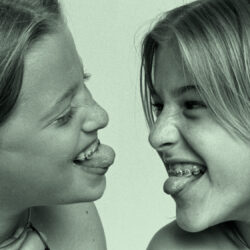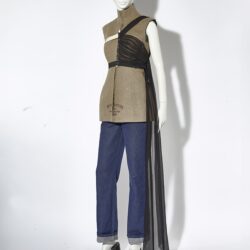Fashion from Antwerp: influence & identity with Walter Van Beirendonck

One such name is, of course, Walter Van Beirendonck. He founded his label back in 1983 and, soon after, combined it with teaching at the Fashion Department of the Royal Academy of Fine Arts in Antwerp. In 1986, Van Beirendonck joined Dries Van Noten, Dirk Van Saene, Ann Demeulemeester, Marina Yee and Dirk Bikkembergs in creating Belgian fashion history as a member of the ‘Antwerp Six’, and in 2007 he was appointed Director of the Antwerp Fashion Department. For decades, and to this very day, the designer has never missed a show during the Paris fashion weeks, not even when they went digital. Van Beirendonck could therefore easily feel like he'd 'made it'. However, as one of the last real independent great designers, his underdog spirit still has bark and bite,

MoMu talks to Walter Van Beirendonck about his bond with Antwerp, about being or not being ‘established’, and what characterizes and connects many of his former students.
MoMu: How would you describe your earliest memories of Antwerp?
WALTER VAN BEIRENDONCK: “My parents had a garage in Zandhoven and I was often allowed to accompany them to Antwerp, where my mother bought spare parts. While we were there, we made the most of the opportunity to go shopping and eat waffles. I remember buying the outfit for my communion at Princess and that we went to the department store of its day, the ‘Innovation’. Some years later, as a young teenager, I knew exactly where to go to find clothes imported from London. It was during my time at the fashion academy that I really got to know the city. I didn't have any student accommodation, but Dirk (Van Saene) did. Together with others in our class we discovered everything: the culture, the museums, the night life. That was a real eye-opener, because we were nearly all from the countryside: Dries Van Noten from Essen, Ann Demeulemeester from West Flanders and me from the Kempen region. There was so much energy when we all came together in Antwerp, it was like a bomb. The ‘Cinderella’ was the place where we went out: an underground discotheque at Stadswaag, very alternative and hardcore. We danced to Bowie, new wave, punk – all kinds of genres. Amazing.”

Looking back, was that also where the Antwerp fashion scene began?
"There was no “scene”. Of course, you had students from the Fashion department, but that was really the small group you already know as ‘The Six’ plus Martin Margiela, who was also in our circle of friends. Martin and I attended photography evening classes together, and we organised our own fashion shoots for our assignments. Inge Grognard already did the make-up back then, and she and her cousin were our models. Did you know, artists like the painters Luc Tuymans and Narcisse Tordoir and his wife Bruna were often found in the ‘Cinderella’ too? I would tend to call it an artistic environment rather than a fashion scene. There were people who put together special outfits and dressed in extreme clothing, so in that respect it was an important space."
Where did you go, as young designers, for inspiration and research?
"The most important factor was the dynamic in that era. Punk reigned in England and you could feel it in Antwerp too. In the area around Wolstraat and Hendrik Conscienceplein the focus lay on the alternative scene - Ann Salens had a shop there. We went there for lunch and to hang around. We also went to museums like the M HKA. However, for inspiration, we travelled to London, Paris and New York. Those trips gave us a huge injection of boost, although Antwerp was still really our home back then."
When did you first get the feeling that your work had been noticed?
After our show in London. We were discovered by the assistant to the press agent Marysia Woronieczka, because we showed as a group. Marysia spontaneously offered to represent us in London. It was when articles appeared in ‘The Face’ and ‘Blitz’ that we first felt like we had something to say internationally.

Did you ever struggle with the fact that you were seen as the group, the ‘Antwerp Six’?
“I don't think any of us had a problem with that. Of course, it was never the intention to be seen as a collective, as we each clearly had our own aesthetic approach or cherished different values and ambitions. However, due to practical reasons, we ended up as a group. It was because of our “difficult” names that the British press named us the ‘Antwerp Six’. A sort of easy option, which fired up the imagination: a group of Belgians who appeared from nowhere and still had an awful lot to say. "
We bombarded the press with invitations, press releases and photos. (laughs) Just imagine: those journalists received a tsunami of visuals, visions and statements from a country that had never before had anything to say about fashion.
All these years later, you and the fashion academy still regularly appear in The New York Times and your designs can still be seen season after season in places like Dover Street Market. Have you ever really felt ‘established’?
“Not really. Continuous doubt is inherent in creative minds. What sometimes confirms your evolution is when museums or people who you look up to are interested in working with you. But it's not like I suddenly think: ‘That's it now. I'm ‘established’ and can do what I want’.”
Are there any common traits that you notice among alumni who have made their name in the fashion industry, after studying at the Academy? In other words: is there an Antwerp or Belgian fashion identity?
“Powerful storytelling. Something that was still very new when we graduated, but you now see it more and more, and also from other academies. Marine Serre, who, as you know, graduated from La Cambre, tells a powerful story. I also think that our versatility is quite typical. Here you are educated to an extremely high level. You have to dig deep and discover yourself, which means you can tackle many different challenges later on. Looking at my interns, I also notice how inspiring it is when they discover how you can still reach a higher level with a small set-up and lots of hard work. That, even working independently, it's still possible to achieve something big."
Yet I am still always surprised when I hear that ex-students have turned their back on large teams and financial security and returned to set up their own label. Take Meryll Rogge for example: she had built a fantastic career in New York and then with Dries Van Noten, yet she still decided to start again from scratch.
"Also, Minju Kim, a model student who really blossomed thanks to the Antwerp methods, has already had a wonderful career. She graduated in 2013 and immediately won the H&M Design Award, she launched her label MINJUKIM and returned to Korea where she won Netflix’ ‘Next in Fashion’ in 2019. Minju still fondly remembers her training and tutors. I saw her recently on a Korean TV show, and she's a huge star. She also has the ambition to set up her own award once the shows start up again. Such ambition, perseverance and determination are quite typical in all of our graduates.”






